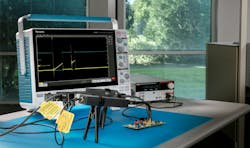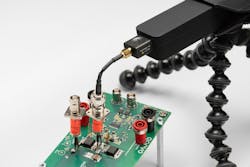For anyone designing DC-DC converters, AC-DC power supplies, or the system around it, understanding the power supply’s operation under both the best and worst conditions is important. The load of the device can change dramatically from one instant to the next, and the power supply must be able to withstand sudden peak loads that far surpass the average operating levels. Power lines can distort, and varying environmental conditions may impact the performance of a power supply.
Most engineers turn to the oscilloscope as their preferred test and measurement tool for power analysis. One of the primary reasons is that they can run measurements in both the time and frequency domains and then correlate them.
For instance, if you change the switching speed of the power supply, you can measure the turn-on and turn-off of the power switch in the time domain and evaluate the impact on electromagnetic interference (EMI) or other unwanted outcomes in the frequency domain.
Tektronix introduced its first family of oscilloscope probes with more robust RF isolation. According to the company, they offer higher accuracy and safety when measuring fast-changing currents across both low- and high-voltage systems.
Building on its IsoVu family of current probes, Tektronix said the TICP series comes with complete galvanic isolation between the oscilloscope and the device under test. The more robust isolation eliminates ground loops and results in common-mode rejection ratios (CMRR) of 140 dB at DC and up to 90 dB at 1 MHz, enabling accurate measurements of current with minimal signal noise. The company called it a major improvement compared with other probes on the market.
With the high-bandwidth probes, engineers are able to capture accurate measurements of fast-changing currents on their oscilloscopes across a wide voltage range in nanoseconds—spanning from microamps to kiloamps. "The wide measurement range covers previously inaccessible high-voltage environments, from fast-switching SiC and GaN power converters to low-power applications like battery performance testing in mobile devices—all with a single probe," said Daryl Ellis, general manager of Tektronix’s entry and mainstream portfolio.
The Future of Power Testing Requires High Bandwidth and Isolation
Understanding the ins and outs of the power supply under these constantly changing conditions is vital. To measure the current traveling in, around, and out of it, the oscilloscope is frequently paired with precision shunts or current-sense resistors. These current sensors are placed on prototypes for testing and removed before mass production. The oscilloscope and the probe paired with it measures sudden changes in voltage as current travels through the shunt and then uses it to determine the current.
However, this is becoming more of a challenge in switch-mode power supplies in applications ranging from electric-vehicle onboard chargers (OBCs) and DC-DC converters to power supply units (PSUs) in data centers and industrial uninterruptible power supplies (UPS). These systems leverage the latest silicon-carbide (SiC) and gallium-nitride (GaN) power FETs. The faster switching speeds of GaN and SiC help them handle higher power levels more efficiently and run cooler, noted Ellis. But the higher frequencies also present testing challenges because the currents in the system change more rapidly.
To measure everything from the characteristics of the power transistor to the ringing and other fluctuations that can occur in the system during switching, the oscilloscope and the probe paired with it must have very high bandwidth. Equipped with that bandwidth, engineers can capture more intricate signals from the system, said Ellis, which is important for improving the overall efficiency of the power supply. High-voltage isolation is also integral for safety—preventing any damage to the device being tested and harm to anyone around it.
>>See more of our coverage of electronica 2024, and check out this Series Library for similar articles and videos
Featuring 250 MHz, 500 MHz, and 1 GHz, Tektronix said the TICP family has the high bandwidth required to stay a step ahead of the high frequencies of SiC and GaN power switching devices, and they can support rise times of less than a nanosecond.
When paired with precision shunts or other current-sensing resistors, these high-bandwidth capabilities enable dynamic current measurements at up to several hundred MHz, said Ellis. “Now, customers can see what’s actually happening from a ripple standpoint when the power transistor is turned on, giving them more fidelity of the signal and the ability to identify any anomalies where the signal is not as smooth.”
The latest probes have robust galvanic isolation so that they can handle the high voltages prevalent in many of these power systems, which could result in EMI and other noise. Tektronix said the TICP series can withstand high common-mode voltages of up to 1.8 kV, giving it up to 10 dB more noise rejection than other solutions on the market and providing engineers with more clarity into power measurements while detecting rare and random events.
“Traditional optical isolation allows you to get to very high voltage range as well as high bandwidth, so 1 GHz and above,” Ellis told Electronic Design. “But one of the challenges when you have these high-speed signals is seeing the smaller signals spread out among the larger signals, and so you need to be able to have higher resolution and reduced noise. With optical isolation, you just cannot get down to the same noise floor.”
All-in-One Oscilloscope Probe Measures from Microamps to Kiloamps
Tektronix said the IsoVu family of oscilloscope probes was initially introduced so that it could accurately measure the relatively high and rapidly changing voltages in high-density power converters based on SiC and GaN.
But one major challenge for customers using SiC and GaN power devices is measuring fast changing and relatively large current steps, said Ellis, specifically currents traveling from drain to source in half-bridge power converters. “The biggest challenge that we've heard from customers, specifically the ones doing higher power designs such as solid-state circuit breakers or uninterruptible power supplies in industrial or electric grids, is measuring the current in there.”
Tektronix said the TICP series helps solve the problem by scaling up to tens of amps of current. But the high bandwidth and wide dynamic range also enable it to measure microamps of current in microseconds, which is critical for other types of power analysis.
The ability to accurately measure smaller amounts of current is also key to improving power management in everything from battery-powered IoT devices to data centers. The high bandwidth and wide dynamic range allow for the capture of fast-changing currents and transients at these levels, too.
For engineers trying to boost the runtime of battery-powered devices, TICP can measure the relatively tiny amounts of current being consumed by specific system activities and during transitions from active to standby modes.
Ellis said Tektronix’s customers are also applying these features to digital power management in data centers, which today is all about efficiently feeding power to GPUs and other AI chips that are burning through thousands of amps of current. “The currents are rising in data centers. But you want the power-management ICs and other chips surrounding the server to draw less current so that it increases the current going into the GPU. It’s testing the components surrounding the GPU where the galvanic isolation in key.”
He added, “As these servers become more complex with increased computing power from GPUs, you have more power rails in the server, and the power-management IC in there for the server is being distributed to several GPUs. So, they want to see the current draw that’s happening on the power-management IC from the power supply when the server is doing the maximum computing. Then, when the server is in the steady or the standby state, they want to know how much current is still being consumed by each one of the GPUs.”
In addition to delivering high bandwidth, Tektronix said the TICP produces less noise, limiting it to approximately 150 µV RMS at 1 GHz, which helps guarantee that the oscilloscope is capturing signals as clearly as possible.
The TICP also comes with minimal impedance of 50 Ω to reduce the impact on the signal during testing. The dynamic range of the series spans from ±0.5 to ±50 V. "One of the bigger challenges that customers have is how to access all these power rails because they are adding more processing power and increasing the complexity of the design. Then, how can they see those very small signals and then get down to the right levels of current so that they can see more of the anomalies they were unable to see before,” said Ellis.
Probing the Oscilloscope’s Future Role in Power Electronics
Further out, Tektronix is trying to solve more practical test and measurement problems for power engineers.
One of the challenges with measuring current is that customers must physically place the shunt inside the device or on the PCB as close as possible to the points where they want to measure the current, Ellis told Electronic Design.
But it can be impractical or impossible for customers to solder in the shunt close enough to the power FET or the power-management IC in the system due to a lack of real estate, noted Ellis. In many cases, these power ICs are placed inside power modules, and then it’s too late to place the shunt inside to measure the current accurately. Even when it fits into the system, the shunt can intrude on the signal, and it can be challenging to physically access the test points with the tip of the probe and source it at the right point within the device.
Tektronix is trying to address the problem in future generations of its probes. “We’re looking at a different and innovative shunt technology that allows for new and different ways of connecting to the device so customers can get closer to where that they want to measure,” said Ellis.
>>See more of our coverage of electronica 2024, and check out this Series Library for similar articles and videos
About the Author
James Morra
Senior Editor
James Morra is the senior editor for Electronic Design, covering the semiconductor industry and new technology trends, with a focus on power electronics and power management. He also reports on the business behind electrical engineering, including the electronics supply chain. He joined Electronic Design in 2015 and is based in Chicago, Illinois.





